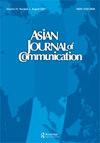The view from the hinterland: caste, gender and press freedom in Hindi news reporting
IF 1.5
2区 文学
Q2 COMMUNICATION
引用次数: 1
Abstract
ABSTRACT The limits to press freedom in India are usually surveyed from the top-down, with a focus on government efforts to censor journalists, particularly English-language journalists. In this essay, we instead examine India's restrictive press culture by focusing on the sociological workings of Hindi language news production, studying ways in which everyday journalism practices intersect with freedom of expression. The paper first traces the history of Hindi journalism alongside the development of press freedom. It then analyzes mainstream Hindi media coverage of the recent murder and rape of a “lower caste” woman in rural India. Our analysis reveals how the sociological realities of casteism and patriarchy merged with self-censorship to enable media cover up of the rape case. We then draw on interviews with Hindi journalists to illuminate the reasons behind censorship in such cases and in news media more broadly. We argue that a combination of structural, ideological, and historical conditions has limited the growth of press freedom in India. We further suggest that top-down approaches that focus exclusively on English-language media cannot adequately capture the dynamics of news reporting on the ground, and that contemporary news media can only be holistically understood by studying the “non-global,” Indian language press.来自内地的观点:印地语新闻报道中的种姓、性别和新闻自由
摘要印度的新闻自由限制通常是自上而下的调查,重点是政府审查记者,尤其是英语记者的努力。在这篇文章中,我们通过关注印地语新闻制作的社会学运作,研究日常新闻实践与言论自由的交叉方式,来审视印度的限制性新闻文化。本文首先追溯了印地语新闻的历史以及新闻自由的发展。然后,它分析了主流印地语媒体对最近印度农村一名“低种姓”妇女被谋杀和强奸的报道。我们的分析揭示了种姓制度和父权制的社会现实如何与自我审查相结合,使媒体能够掩盖强奸案。然后,我们利用对印地语记者的采访来阐明在这种情况下以及更广泛的新闻媒体中审查制度背后的原因。我们认为,结构性、意识形态和历史条件的结合限制了印度新闻自由的发展。我们进一步认为,只关注英语媒体的自上而下的方法无法充分捕捉当地新闻报道的动态,而当代新闻媒体只能通过研究“非全球性”的印度语媒体来全面理解。
本文章由计算机程序翻译,如有差异,请以英文原文为准。
求助全文
约1分钟内获得全文
求助全文
来源期刊

Asian Journal of Communication
COMMUNICATION-
CiteScore
3.70
自引率
0.00%
发文量
38
期刊介绍:
Launched in 1990, Asian Journal of Communication (AJC) is a refereed international publication that provides a venue for high-quality communication scholarship with an Asian focus and perspectives from the region. We aim to highlight research on the systems and processes of communication in the Asia-Pacific region and among Asian communities around the world to a wide international audience. It publishes articles that report empirical studies, develop communication theory, and enhance research methodology. AJC is accepted by and listed in the Social Science Citation Index (SSCI) published by Clarivate Analytics. The journal is housed editorially at the Wee Kim Wee School of Communication and Information at Nanyang Technological University in Singapore, jointly with the Asian Media Information and Communication Centre (AMIC).
 求助内容:
求助内容: 应助结果提醒方式:
应助结果提醒方式:


